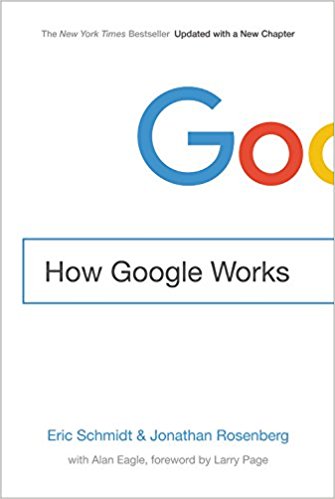How Google Works – Eric Schmidt and Jonathan Rosenberg
How Google Works is another great book from Silicon Valley. Many Technology Business bestsellers tend to originate from Silicon Valley. Thanks, Eric and Jonathan for offering insights on Google. I think the intent of writing this book is also to help people at Google. (A great orientation guide). You both have been very generous investing your time writing this book. At DCKAP, I have recommended everyone to read How Google Works. It helps in transparency and also to build on our skills. Here are notes I took from the book.
Technical Insights: When you work on a product, you need to know what the technical differentiator is. A new product should be driven by Technical Insights. Why are we building this product? What is the technical insight? Is it me too product or is the product direction driven by strong technical insights?
Technical Leaders: Product differentiation is the new way to sell. What product features aid selling? Is sales a seamless process? One thing which was fascinating was to understand technology selling. Technical people are the superstars. Products at Google are run by people with a strong technical background. Sundar Pichai ascending to be the CEO of Google is a great example of this. He is a technology leader. The ones running the company should be product people. Scaling should be a key part of your strategy.
Hiring: Eric and Jonathan offer a hiring guide and they dedicate a chapter on this book. What is the most important thing you do at work? – ‘Hiring’. I highly recommend every Human Resource professional to read this chapter on Hiring and also the entire book. Majority of your workforce should be engineers. Invest in technical talent. Post-reading this book, we created our own hiring guide for DCKAP. Hiring learning animals is the key. Hire people for what they don’t know and not for what they already know. Are they curious? Don’t hire just based on their ability to code on a particular language. What books are you reading right now? Can I see your phone (to know what apps one is using? Hiring is a group decision and not an individual call (as the person being hired can work on any team). ‘Pay outrageously smart people, outrageously well’ – quote from the book.
Smart Creatives: This word is used extensively across the book. A Smart creative has a deep technical knowledge and is also a learning animal. He/she is curious. The emphasis is also to Think Big. It will become hard to retain Smart Creatives if we do not provide them with challenging work or a big problem to solve. Credits for Google employees are provided throughout the book. It was good to read more on what the Smart Creatives at Google did (Marissa Mayer, Sheryl Sandberg and more). Bigger problems attract big talent. Thinking Big is a powerful recruiting and retention tool.
Office Design & Crowded offices: This was an interesting learning and something I learned. Offices should be crowded. Open spaces aids interaction. Do not work in silos. When no one has a private office, no one complains about it. Be very generous with resources that are needed to do the work and stingy with stuff that is not critical (fancy furniture). Employees should have the option to retire to a quiet place when needed (more meeting rooms). Humans are at their best when they are surrounded by social controls and crowded offices help this. These are quotes from the book.
Transparency and Free Flow of Information: In a technology business free flow of information is vital. Open Communication and everyone being aware of what is happening in the company is the best way to run a business. Have company-wide weekly meetings where people discuss or ask anything. We started Weekly Voices at our workplace. Whenever possible, avoid secret organizational documents. Open up calendars of all staff so anyone can see what other people are working on. OKRs (Objective, Key Results) should be public. Snippets (keeping note of daily tasks for anyone to see) was also interesting.
Platforms/Community: Great companies are built on great communities (or) ecosystems and this is talked about in the book as well (Not extensively). Spend a vast majority of your time thinking about product, community, and platform.
Other interesting notes/quotes from the book: Praise is underappreciated and underused as a management tool. Focus on the user, money will follow. Products that get better and gather momentum should be rewarded with more resources. Products that stagnate should not. Encourage employees to ask hard questions. Could you make your products so great that customers want to stay even if they don’t want to? What percentage of your products are built on unique technical insights? Does a company aggressively reward and promote people who have a big impact on creating excellent products?
Thanks, Eric and Jonathan. Happy Reading.




Leave a Reply